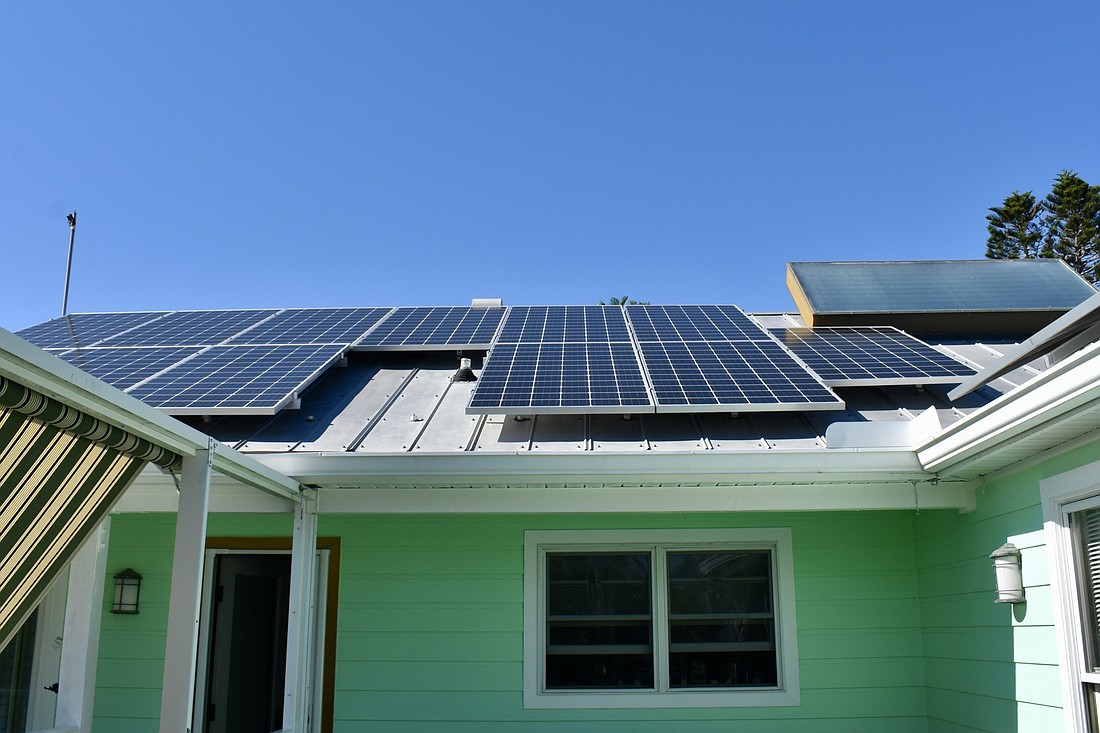- November 13, 2025
-
-
Loading

Loading

At least one house Longboat Key didn't go dark because of Hurricane Ian's power outages, and luck had nothing to do with it.
Rusty Chinnis and Chris Killeen have 21 solar panels installed on their Longbeach Village home's roof and two Tesla Powerwall battery packs to back them up. While the rest of the neighborhood remained dark, quiet and humid, Chinnis and Killeen were running their 2,500 square-foot house and two Tesla sedans on those batteries.
The Powerwalls were a more recent purchase and cost as much as the panels at $16,000 after tax credits, but Chinnis said they’re well worth the added expense.
Without them, the couple would’ve been powerless like everyone else on the island, including Kevin Pass who also has gone solar, but not to the extent as his neighbors to the north.
Pass has solar panels on his house in Sleepy Lagoon but, for safety, lost power along with the rest of Florida Power & Light customers when Ian caused a widespread outage. With his installation, solar power cells could have electrified otherwise dead power lines, potentially injuring utility workers.
His system is designed to cut off in an outage.
Pass and Chinnis say they are happy with their purchases. Chinnis acknowledged it’s a costly endeavor, but said they could afford it and it’s the right thing to do.
Pass had his own humorous take on the cost.
“We’re all old out on Longboat Key, so five to seven years before it pays for itself doesn’t mean as much to us,” he said laughing.
Pass is referring to the tax credit, which was upped from 26% to 30% in August. The credit is good on both equipment and installation.
A larger house requires more panels. Pass’ 52-panel set up cost about $40,000 out-of-pocket. A battery would cost another $20,000 before the tax credit. Spreading out the two installations can be advantageous from a deduction standpoint.
Pass noticed the panels didn’t produce as much power in September versus some of the sunnier months, but he’s pleased with the overall offset on his electric bill.
The panels were installed in May, but it took until July to see the savings. Only one week on that statement shows his family consuming more power than the panels were producing. His FPL bill plummeted from $356.75 a month in June to $43.38 in July and $27.16 in August.
Chinnis' battery system detects and takes over automatically during power outages. Transitioning on and off the grid is seamless.
Chinnis needed two, but up to 10 Powerwalls can be combined for a bigger backup system, which is akin to using a high-tech generator. A homeowner can decide to run everything until the battery runs out or decide to only use essentials.
Instead of having to pull the refrigerator out from the wall to get to the plug, the homeowner tells an app to keep it running and maybe chooses to turn off the stove or television outlets. Managing the essentials manually only takes a walk to the circuit breaker box to flip the switches on what isn’t essential.
Both men bought from Bryan Hammond at Solar Source. He’s in sales now, but was a technician in the solar industry for 10 years prior. Hammond also happens to live in Punta Gorda and was in the thick of 140 mph sustained winds and 170 mph gusts.
“My solar panels were intact. I did have two of them that let loose after about four hours of wind, “ Hammond said. “They landed on my front lawn. The next day, I put them back up, and they worked perfectly fine.”
Most panels can survive a Category 4 hurricane with 140 mph winds if properly installed, and some are designed to withstand even more. Still, Hammond got lucky with the two that went flying. They landed in the grass. Some of his clients weren’t as lucky when their panels hit concrete.
Hammond sheltered in place during Ian and felt safest on the side of his house that has panels. Solar Source advises some homeowners to wait on a new roof before installing panels as to not have the opposite effect, but combining a strong roof with solar panels can make the house more structurally sound to withstand a hurricane, they say.
“It doesn’t necessarily improve the integrity of the shingles or tiles, but it’ll improve the integrity of the structure of the roof,” Hammond said. “We’re spanning aluminum and attaching that to those trusses, so you’re really just adding extra support to the roof on the top side.”
Neither Chinnis nor Pass lost any panels during Ian, and both evacuated the island. Evacuation orders will remain unavoidable when a hurricane is bearing down, but with solar panels, there is a way to avoid a power outage during the aftermath—buy batteries.